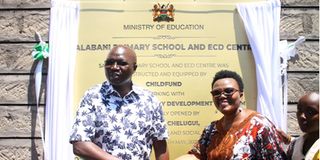Baringo’s flood-hit Salabani Primary School relocated

Labour and Social Protection CS Simon Chelugui and Childfund Country Director Alice Anukur when they officially opened newly-constructed classrooms at Salabani Primary School in Baringo. The school was swept away by floods in 2020.
Salabani Primary School that was in 2020 destroyed by floods from Lakes Baringo and Bogoria rising water levels, has been relocated to a higher ground and new classrooms constructed.
The school, located in Baringo County, has undergone a significant makeover, giving it a fresh new look at a cost of Sh30 million. The rehabilitation was sponsored by ChildFund Kenya, which caters to the welfare of children. Working with the Central Rift Community Development Program (CRCDP), ChildFund constructed eight primary and two ECD classrooms, an administration block, as well as pit latrines.
ChildFund Kenya Country Director Alice Anukur said that the primary section has been equipped with 400 desks while the pre-primary level got 170 chairs and 45 tables.
Enrolment and transition are expected to grow as the school has a favourable learning environment. The new structures were officially commissioned by Labour and Social Protection Cabinet Secretary Simon Chelugui, who underscored the need to create a supportive learning environment for children.

Salabani Primary School pupils outside their new classrooms. The school in Baringo County was destroyed by floods in 2020.
“The new structures provide comfortable and safe learning environment for children while staff and employees have a modern and spacious administration block,” said Ms Anukur.
Salabani Primary and Early Childhood Development centre were hit hardest by the flooding in Baringo County, leading to temporary closure after it was submerged.
The school relocated to a new site with make-shift iron sheet structures that were not comfortable for learning.
She further noted that climate change is increasingly becoming a threat to children’s lives.
“Climate change drives inequality and prolongs poverty traps, with children and adolescents particularly exposed,” commented Ms Anukur.
She said floods create extra barriers to education in areas where rising hunger, ongoing conflict, and the impact of the Covid-19 pandemic have already affected children’s learning.
“Up to two-thirds of preventable illness and death from environmental hazards such as flooding is experienced by children, with the burden predominantly in those aged under five years,” she added.
According to ChildFund, every year, around 1.5 million children see their education interrupted in Kenya – and half of them drop out of school because of climate and environmental threats.
Ms Anukur further noted that children out of school are at greater risk of being abused and exploited or recruited into child labour or into armed groups. She singled out girls as the most at risk as they are less likely to return to school once lessons resume as many become victims of early marriage.
“Developmental gains in education are offset due to damage or destruction of school facilities due to flooding, extended disruption of education, and limited access to schooling,” she said.
Globally, 900,000 people have been affected, 50,000 displaced and 400 died due to floods and landslides since August 2021, according to ChildFund statistics.
“These challenges compromise children’s rights and access to quality education and sets up an unfortunate cycle of poverty and inequality as without a proper education, there is little chance of improving one’s situation later in life,” she concluded.





